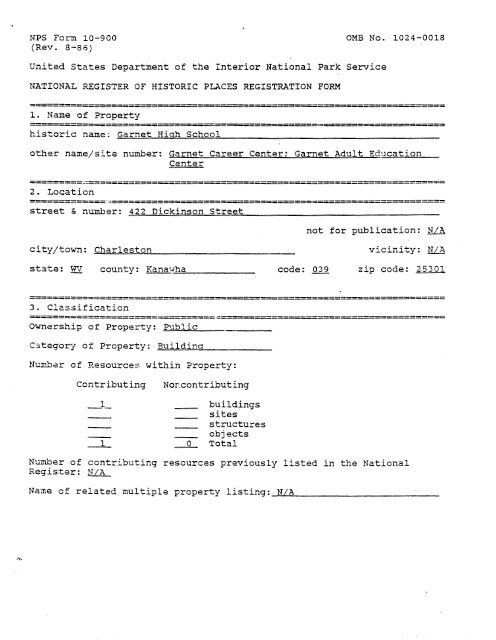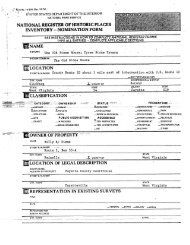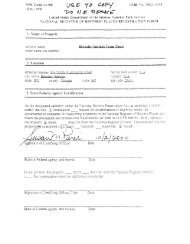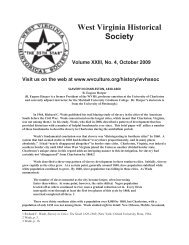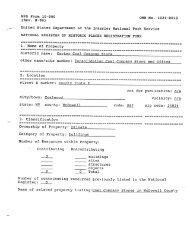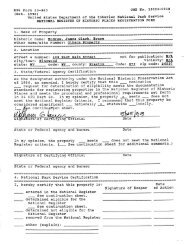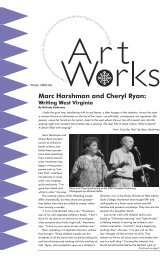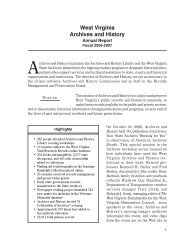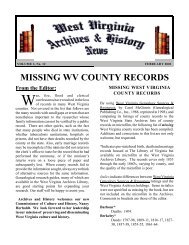Garnet High School - West Virginia Division of Culture and History
Garnet High School - West Virginia Division of Culture and History
Garnet High School - West Virginia Division of Culture and History
- No tags were found...
You also want an ePaper? Increase the reach of your titles
YUMPU automatically turns print PDFs into web optimized ePapers that Google loves.
-=================================NPS Form 10-900(Rev. 8-86)OMB No. 1024-0018United States ~e~artment <strong>of</strong> the Interior ~ational Park serviceNATIONAL REGISTER OF HISTORIC PLACES REGISTRATION FORM---- ---------------------===_-_--=-~====-------- ------------I. Name <strong>of</strong> Property- ----======-====-==-=-- ---------------------historic name: <strong>Garnet</strong> Hiqh <strong>School</strong>-----------other name/site number: <strong>Garnet</strong> Career Center: <strong>Garnet</strong> Adult ducati ionCenter2. Location-------------..---------------------------------------------------__.____--_-_-_-----_-----_----------------------------street & number: 422 Dickinson Streetcity/town: Charlestonnot for publication: N/Avicinity: N/Astate: county: Kanawha code: 039 zip code: 25301-----------------I-----Ownership <strong>of</strong> Property: P~blicCategory <strong>of</strong> Property: ~uildinaNumber <strong>of</strong> Resources within Property:Contributingorc contributing-- Ibuildings- sitesstructures- - objects1- 0 TotalNumber <strong>of</strong> contributing resources previously listed in the ~ationalIiegister: N/AName <strong>of</strong> related multiple property listing: N/A
United States Department <strong>of</strong> the InterforNational Park ServiceNational Register oi Historic PlacesContinuation Sheet .Section number Page 2Well preserved interior components include the intact buildingplan, spaces, architectural features, <strong>and</strong> various finishes <strong>and</strong> materials.<strong>Garnet</strong>'s lobby, auditorium, <strong>and</strong> gym, opening <strong>of</strong>f the main entrance,present excellent ornamental plaster mouldings, millwork, <strong>and</strong> woodfloors.. Hallway floors are covered with terrazo.The central spaces within the building are dominated on floors one<strong>and</strong> two by the auditorium <strong>and</strong> gym. Hallways <strong>and</strong> classrooms are found onthe perimeters. The principalls <strong>of</strong>fice <strong>and</strong> library on the second floor,<strong>and</strong> book store with "Dutch door," are intact. Classrooms throughoutfeature original blackboards, baseboards, hardwood floors, oak trim, <strong>and</strong>paneled wood doors. ~xtending the building to the south is the lateraddition containing an auto shop <strong>and</strong> classrooms.
United States DepartmentNational Park Service<strong>of</strong> the InteriorNational Register <strong>of</strong> Historic PlacesContinuation SheetSection number Page 2Despite this <strong>and</strong> other hardships, which weren't necessarilyrecognized at the time, the students <strong>and</strong> teachers were for the most partone big happy family. This is evident by the number <strong>of</strong> former Black <strong>High</strong><strong>School</strong> Reunions that take place now throughout the state. This leads toanother point-the friendship <strong>and</strong> enjoyment <strong>of</strong> the competition among theschools. Football <strong>and</strong> basketball games, tournaments, commercialcontests, track meets, play (drama) tournaments, marching b<strong>and</strong>s-all alongwith academia, contributing to the development <strong>of</strong> a well rounded student.Our rivals, Douglass (Huntington), Simmons (Montgomery), Washington(London), State Hi (Institute), Kelly Miller (Clarksburg), Sumner(Parkersburg) , Dubois (Mount Hope) , Aracoma (Logan) , Lincoln (Hinton <strong>and</strong>Wheeling), Conley (Mullens), Gary (Gary), Excelsior (~xcelsior) , Stratton(Beckley), Byrd Prlllerman (Amigo), Park Central (Bluefield), Dunbar(Faimont), Liberty (Williamson), <strong>and</strong> Ximball (Ximball) are a part <strong>of</strong> theesteemed history <strong>of</strong> <strong>Garnet</strong>, as <strong>Garnet</strong> is a part <strong>of</strong> their esteemed history<strong>and</strong> all a part <strong>of</strong> the history <strong>of</strong> education in the state <strong>of</strong> <strong>West</strong> <strong>Virginia</strong>.Throughout its fifty-six years <strong>of</strong> existence, <strong>Garnet</strong> as a Black <strong>High</strong><strong>School</strong> was guided by four principals, C.W. Boyd, J.F.J. Clark, Scott M.Brown, <strong>and</strong> Harry E. Dennis.Mr. Boyd, born in Mt. Sterling, Kentucky, came to Charleston as ateacher in 1892 <strong>and</strong> organized <strong>Garnet</strong>t <strong>High</strong> <strong>School</strong> in 1900. This grew out<strong>of</strong> a graded school by the same name, being named for Henry <strong>High</strong>l<strong>and</strong><strong>Garnet</strong>t. Although being born a slave in Maryl<strong>and</strong>, Mr. <strong>Garnet</strong>t <strong>and</strong> hisparents escaped from slavery <strong>and</strong> settled in New York City. He attendedschool, graduating from college, <strong>and</strong> continued his education by becominga minister. He became a leader <strong>of</strong> the abolitionist movement.Mr. Boyd was made <strong>Garnet</strong>t's first principal <strong>and</strong> held that positionuntil 1908 when he became Supervisor <strong>of</strong> Charleston Negro Public <strong>School</strong>s.He later became principal <strong>of</strong> Boyd Junior <strong>High</strong> <strong>School</strong>, when it came intoexistence. Mr. Boyd retired in 1936 after forty-five years in theteaching pr<strong>of</strong>ession.Mr. J.F.J. Clark became <strong>Garnet</strong>t's second principal in 1908. A yearlater a separate high school building, the first <strong>of</strong> its kind for theinstruction <strong>of</strong> Negro youths in the state <strong>of</strong> <strong>West</strong> <strong>Virginia</strong>, wasconstructed on the same plot <strong>of</strong> ground with the grade school building,located on Jacob Street. The growth <strong>of</strong> the high school was such that in1927 a new building, <strong>and</strong> location was proposed- -at the corner <strong>of</strong> Lewis <strong>and</strong>Shrewsbury Streets. In addition to conventional classrooms, this'xilding included an auditorium, gymnasium, library, cafeteria, specialmms for sewing, domestic science, mechanical drawing, printing, <strong>and</strong>separate laboratories for chemistry, physics, <strong>and</strong> biology. Throughoutits years the building always maintained its newsness.
United States Department <strong>of</strong> the lnterlorNational Park ServiceNational Register <strong>of</strong> HistoricContinuation SheetSection number 8 Page 3There was no campus. We didnVbt realize the lack <strong>of</strong> one or complainabout not having one. The building opened directly on the streets.Perhaps that is the reason for persons around the czuntry having anattachment for Shrewsbury Street.It has been said that when the school name was cut in thecornerstone <strong>and</strong> the arch over the entrance, the stone cutting companyomitted one <strong>of</strong> the It's in <strong>Garnet</strong>t's name. The Board <strong>of</strong> Education didnot require them to correct the mistake. Thus, after 1929, the schoolbecame <strong>Garnet</strong>, with one It'.Under Mr. Clark's leadership, <strong>Garnet</strong> developed into a first-classsenior high school. He retired from active service as principal in May,1946, having served for almost four decades. Many, many studentsremember Mr. Clark.September <strong>of</strong> It46" saw Mr. Scott M. Brown at the helm <strong>of</strong> <strong>Garnet</strong>. Hehad been principal <strong>of</strong> Wake Forest Junior <strong>High</strong> for eight years, <strong>and</strong>principal <strong>of</strong> Boyd Junior <strong>High</strong> for two years. He continued the tradition<strong>of</strong> excellence at <strong>Garnet</strong>, <strong>and</strong> in June 1949, he became AssistantSuperintendent <strong>of</strong> <strong>School</strong>s.September 1949, Mr. Harry E. Dennis became <strong>Garnet</strong>'s fourth <strong>and</strong> lastprincipal. Prior to coming to <strong>Garnet</strong> <strong>High</strong> as principal, Mr. Dennistaught at Dunbar <strong>High</strong>, Weirton; Lincoln <strong>High</strong>, Wheeling; <strong>West</strong> <strong>Virginia</strong>State College; <strong>and</strong> was principal <strong>of</strong> Carter G. Woodson Junior <strong>High</strong>, St.Albans .The U.S. Supreme Court's decision <strong>of</strong> 1954 declaring "separate, butequalft unconstitutional would naturally-have its effect on all Blackschools. So it was that Mr. Dennis presided at <strong>Garnet</strong> s lastcommencement May 25, 1956.Shortly thereafter <strong>Garnet</strong> lost its identity <strong>and</strong>John Adams Junior <strong>High</strong>, but in a later ceremony afterwas constructed on South Hills, the building was renamedEducation Center. It so remains today.became known asa new John. Adamsthe <strong>Garnet</strong> AdultFrom the thous<strong>and</strong>s <strong>of</strong> students who passed through the halls <strong>of</strong><strong>Garnet</strong>, who are scattered across the country, who are in every walk<strong>of</strong> life, <strong>and</strong> who have happy memories, a Great Big Thank You to theprincipals, teachers, <strong>and</strong> staff who, at sometime during its fifty-sixyears, were a part <strong>of</strong> <strong>Garnet</strong>'s history.
United States Department <strong>of</strong> the InteriorNational Park ServiceNational Register <strong>of</strong> Historic PlacesContinuation SheetSection number 8 PageSuch love <strong>of</strong> school <strong>and</strong> each other so exist today that every threeor four years a thous<strong>and</strong> or more former students return home to attend<strong>Garnet</strong>'s Reunion. It is a joyful <strong>and</strong> heart warming occasion. <strong>Garnet</strong>will live many more years.<strong>Garnet</strong> <strong>High</strong> was famous in <strong>West</strong> <strong>Virginia</strong> for the quality <strong>of</strong> itsprograms <strong>and</strong> curriculum. Its graduates attained renown in manypr<strong>of</strong>essional fields such as medicine, dentistry, law, education, socialwork, music, the airline industry, <strong>and</strong> the militaq. Among famousgraduates are Tony Brown, host <strong>and</strong> president <strong>of</strong> Tony Brown ~roductions<strong>and</strong> Tony Brown Journal; Dr. John C. Norman, a leader in thoracic <strong>and</strong>cardiovascular surgery (his father became <strong>West</strong> <strong>Virginia</strong>'s eregistered black architect <strong>and</strong> engineer); Rev. Leon ~illivan, for over 30iears pastor <strong>of</strong> the largest black church in Philadelphia <strong>and</strong> the firstblack member <strong>of</strong> the Board <strong>of</strong> Directors <strong>of</strong> General Motors Corpo- Lation; <strong>and</strong>Lewis R. Smoot, Sr., president <strong>and</strong> CEO <strong>of</strong> the Sherman R. Smoot Company <strong>of</strong>Columbus, Ohio.Another significant aspect <strong>of</strong> <strong>Garnet</strong> <strong>High</strong> <strong>School</strong> is the 1960saddition which meets National Register criterion consideration G. Thisextension <strong>of</strong> <strong>Garnet</strong> <strong>High</strong> <strong>School</strong> is <strong>of</strong> 10 0rj-anc.e as a work <strong>of</strong> JohnC. Norman (1892-1967), <strong>West</strong> <strong>Virginia</strong>'s gistered black architect.Norman attempted to integrate the newer unit with the older using adesign obviously contemporary but possessing, setbacks, scale, <strong>and</strong>textures complementary to the older building.<strong>Garnet</strong> <strong>High</strong> <strong>School</strong> has achieved significance under criterionConsideration G because <strong>of</strong> the special importance the building played inthe life <strong>of</strong> the black community before 1956, the year the school closed.An illustration <strong>of</strong> that importance is the branch library <strong>of</strong>. theCharleston library system which located at <strong>Garnet</strong>. public libraryresources were thus made available to the city's black citizens through<strong>Garnet</strong> <strong>High</strong>.
United States Department <strong>of</strong> the InteriorNational Park ServiceNational Register <strong>of</strong> Historic PlacesContinuation SheetSection number 8 Page 5Period <strong>of</strong> SianificanceThe period <strong>of</strong> significance begins with the construction <strong>of</strong> thebuilding, 1928-29, <strong>and</strong> extends to the year <strong>of</strong> the building's closure in1956. The excellent state <strong>of</strong> the building's preservation is the result<strong>of</strong> the pride that both the black community <strong>and</strong> student showered upon itduring the decades <strong>of</strong> its service to Charleston area blacks.The <strong>Garnet</strong> Hiqh <strong>School</strong> Name<strong>Garnet</strong> <strong>High</strong> <strong>School</strong> was named for Henry <strong>High</strong>l<strong>and</strong> <strong>Garnet</strong>t(1815-1882), a noted black clergyman, abolitionist, <strong>and</strong> diplomat.<strong>Garnet</strong>t was born in Maryl<strong>and</strong>, a descendant <strong>of</strong> M<strong>and</strong>igo.peoples <strong>of</strong> AfricanSudan. Escaping from slavery, <strong>Garnet</strong>t settled with his parents in NewYork City. After graduation from Oneida Institute near Utica, N.Y.,<strong>Garnet</strong>t became a leader in the abolitionist movement. ~ctive in GreatBritain <strong>and</strong> in international peace movements <strong>Garnet</strong>t was appointed U.S.Consul General to Liberia by President Garfield.
United States Department <strong>of</strong> the InteriorNational Park Servicelational Register <strong>of</strong> '~istoric PlacesContinuation Sheet .Section number 9 Page 1<strong>Garnet</strong> <strong>High</strong> <strong>School</strong> dedication program, December 2-4, 1929.R<strong>and</strong>all, James D.1989.<strong>and</strong> Anna E. Gilmer. Black Past. Charleston, W.V.,R<strong>and</strong>all, James D. st<strong>West</strong> <strong>Virginia</strong> Historic Properties Inventory Form."<strong>Division</strong> <strong>of</strong> <strong>Culture</strong> <strong>and</strong> <strong>History</strong>, 1987.
CHARLESTON WEST QUADRANGLEWEST VIRGINIA-KANAWHA CO. ' ,b0 +\+u G7.5 MINUTE SE.SIES (TOPOGRAPHIC)SW14 CilARLESTON IS' QUADRANGLE,+I,.'


